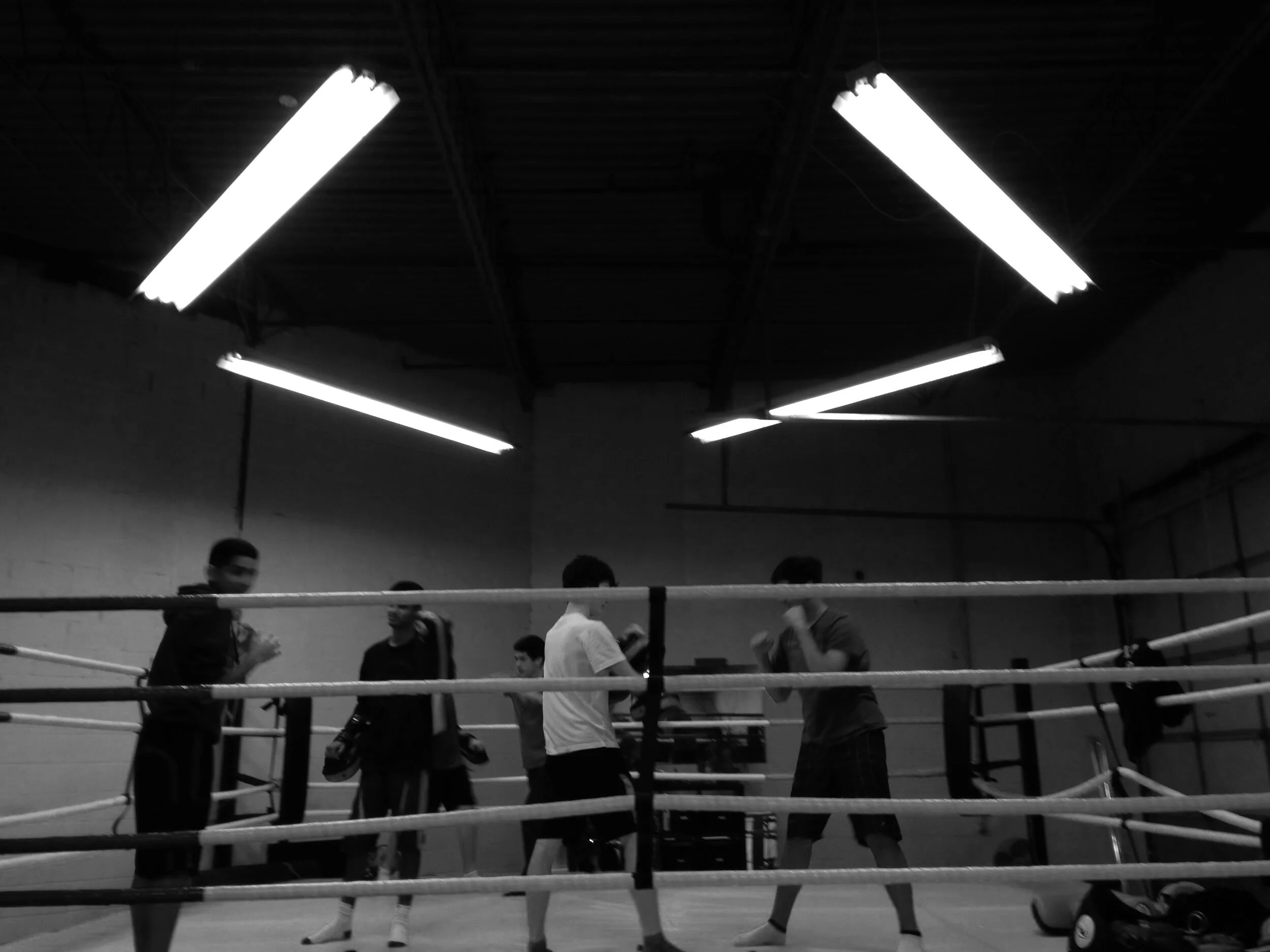How to Teach the Basics
After the group warm-up (which ends at the 45 min. mark), it’s time to introduce the trial to the technical portion of class. If the trial isn’t a complete beginner, they may integrate with the rest of the class. However, for those who are trying Muay Thai for the first time, it’s better to provide them a more thorough intro to the sport.
Before you teach the trial, make sure your tools are nearby. Also encourage the trial to have their water bottle in the area so they can access it easily instead of going through the class during drills:
•Pads
•Timer (class time is limited and you need to be efficient with how long you spend on the drills)
•Water (teaching means talking, hydrate to avoid speaking with voice cracks lol)
I. Shadowbox (10 Min.)
Before striking with power on the pads, teach your trial how to stand and strike without the target: this allows the trial to focus on having good form and balance first. Take note of the following as you go through the phases in each set:
•Demonstrate the form first in front of them or next to them (if you are in front of the mirror) before sharing instructions.
•Give the step-by-step delivery for each phase of the stance or weapon: the starting form, the delivery to the target, and the exit.
•Always lead the count so trials can reset accordingly.
•For the first five reps, let the trial proceed without feedback so they can get a feel for their weapons. If there are any obvious mistakes after those five reps, provide just one correction and reinforce it occasionally, but not too frequently. If there are any improvements, make sure to acknowledge them with a smile.
-
Teach the stance from the ground and work your way up:
LEGS
• Start with your feet shoulder-width apart in a parallel position.
• Take the right foot and place in the back at a 45° angle from the left/lead foot, with a forearm’s length apart distance between the two feet.
• Ensure the lead foot is facing straight ahead, while the rear foot is pointed to the right.
• Bend both knees (but not too low).
TORSO
• Slightly rotate your torso so the lead/left side is forward, while the rear/right side is behind.
• Keep your core coiled.
• Relax the shoulders while keeping your hands up by the cheekbones.
• Keep your chin down with eyes up to the front.
-
From the stance, teach the oscillation. Oscillation is akin to keeping the car engine “on” at a red light; it’s the momentum builder that allows fighters to stay active with small weight shifts before driving bigger movements for powerful strikes.
• From orthodox/left side forward: anchor lead/left foot, followed by the rear/right foot x 15 reps
• Teach how to switch stance “Golden Triangle” Step: lead foot moves back parallel to the rear foot, while the new lead stance replaces the former front food x 20 reps
• From southpaw/right side forward: anchor lead/right foot, followed by the rear/left foot x 20 reps
-
Each month will focus on a particular weapon, and it only makes sense to get the trial up to speed on what will be expected should they continue in the near future.
Teach the basic form of the “weapon of the month” and its compliment (ex. If it’s push or swing kick, also teach the straight punch; if the trial doesn’t have gloves, teach the side elbow. If it’s knee, teach the side elbow.) Don’t teach more than two at a time to avoid overwhelming the trial.
• Start with the arm weapon (e.g. If it’s kick month, teach the how to throw the punch/elbow first before the kick).
• Mirror the movements with them x 15 Reps
• Allow the trial to do the reps on their own without you mirroring x 15 Reps.
• Once one weapon on one side (orthodox/left side forward) is completed, move on to the next side.
• Once the trial has learned one weapon on both sides, repeat the same teaching formula to the next weapon for both sides.
II. Padwork (20 min.)
At the end of the shadowbox set, the trial should have some understanding of the stance and form; now they can move on to landing the weapons on a target. When trials first hit the pads, prioritize the proper mechanics, and only after they demonstrate proper delivery, do you focus on the power (e.g. during a swing kick, make sure the shin makes contact on the pad and not their ankle.)
-
From the stationary position, hold for 20-30 reps per weapon sets (switch sides after):
• Lead (L) arm only*
• Rear (R) leg only
• (L) arm + (R) leg
• (R) leg + (L) arm
• (L) arm + (R) arm
*If they do not have their own gloves, let them elbow instead of punching the pads with their bare hands. Do not lend your gloves for hygiene purposes.
-
Now that you’ve established the basic combinations per side, it’s time to talk less and just let them hit more.
• Focus on using one side per round (e.g. orthodox for round 1, southpaw for round 2) as you cycle through the different options.
• Allow the student to get more familiar recognizing the available targets, while balancing when to stop and correct their form.
• Although there are plenty of combination options, allow your trial to get good at up to 3 max.
• After the first round ends, give the trial a breather/water break (if necessary) before continuing to the next side/round.
-
Like the warm-up finishers, the skillset finishers should be simple yet challenging to build tolerance during high intensity exchanges:
• 60 sec. - 45 sec. - 30 sec. Nonstop Single or 2 Hit Combo/side with 15 second break in between*
*Like the breaks in regular class, this means keeping the hands up :) However, be lenient with the trial if they display signs of dizziness (e.g., paleness in their face and lips, fatigued eyes).
III. Shadowbox Review (5 Min.)
Depending on the trial’s energy level after the padwork, finish the training session with a review of the weapons. Keep the vibe light and encouraging (again, less focus on the mistakes and more on the effort). During this review, stand to the side and not directly in front of the trial to give them space.
-
During the structured round, call for the different weapons taught during the session. Give time for the trial to reset and oscillate before calling the next one.
-
After the structured round, give the trial more freedom to explore. Instead of calling out the weapon, call out the total number for a combination (e.g. 1=single hit, 2=two hit, 3=three hit) and the trial can now choose which weapons they’d like for that combination. Similar to the structured round, give time in between combinations so they can reset.
“Practicing with purpose is the key to progress.”



